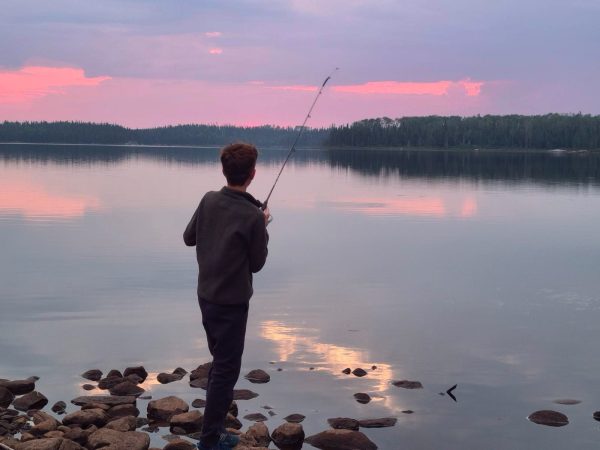Walking into a fishing store for the first time, it can be overwhelming to decide from the thousands of lures, reels and rods lining every wall and aisle, and it’s difficult to know where to begin.
When looking for the best gear, first decide what type of fish you plan to catch. In the Midwest, there are three main categories:
Bass, which is the most common type of fishing.
Pan fishing, which is best if you want a large quantity of fish.
Muskie/pike fishing is for people who are looking for the most elusive fish in the Midwest.
For bass fishing, the first thing you need is a rod and reel, and these come in a broad range of prices and types. If it is your first time getting a rod, it’s best to find something in the medium price range, probably around $50-$100. Some brands popular among professionals are Shimano, Lews and Abu Garcia. Look at the weight, length and type of rod for bass; a common starter is a 7-foot casting rod with a medium action. For the reel, choose the gear ratio, which changes the amount of line that gets reeled in with each turn of the handle. For the gear ratio, a good size to start with is 7:3:1, which gives the reel a medium retrieval speed. For size, a good medium is 150.
When it comes to lures, there is no one answer; it’s all dependent on the lake, the time of year and the weather. Spring fishing is the slowest type of fishing due to the cold waters and the fish being slower. It’s often best to use soft plastics, which give the fish more time to react to the lure and are more likely to bite.

In summer, the water gets warm and the fish are more energetic as they prepare to spawn, making them attracted to faster-action lures. Some options for this are hard plastic lures such as single-blade spinner baits and frogs. These lures move faster across the water and trigger the fish’s hunting instincts with their vibrations and flashes.
Fall fishing is the easiest of all the seasons. It’s the time to catch the biggest fish because they are starting to get ready for winter, when food is scarcer, so they will eat more food and be less picky about what they eat. In addition to those already named, whopper plopper, small crank baits and swim baits are all meant to target more aggressive fish.
Moving on to bluegill and pan fish, not much changes throughout the year, and in general, lighter setups are better. A 5-foot ultra-light spin combo will help you cast lighter baits more easily, and for bait, you can use any sort of small worm, corn or even bread. Bluegill and pan fish mostly sit under large docks and trees and in large groups.
If you’re looking for bigger fish, consider northern pike and muskie. These are the biggest and most aggressive types of predatory fish in the Midwest. While northern pike are less picky, the muskellunge is considered one of, if not the hardest, freshwater fish to catch, with the nickname the “fish of 10,000 casts” due to its tendency to sit and watch a lure without biting.
To start, you want a much heavier setup because these fish can get big. An 8-foot-long casting rod with heavy weight and high action works great, and consider a 300-400 series reel with a 5:8:1 or a 6:3:1 ratio, depending on the options for the reel you are looking at. This is good for the heavier, bigger baits used for northern and muskie.
For lures, the main idea is the bigger is better, especially for muskie, which will take lures anywhere from 5 to 20 inches. Muskie season doesn’t open in most areas until early June, northern season usually opens in early May, and there are a lot of options for lures to use.
In general, northern are more likely to bite if they’re angry, so any lure that makes vibrations is good during typically slow spring fishing. Some examples are chatter baits, crank baits and rapalas. During summer, northern are looking to eat fish that catch their eye, and any sort of spinner, spoons or inline spinner baits should work well. In the fall, northern will bite anything that looks appealing to them, with large whopper ploppers, 14-inch inline spinners and bulldogs being some of the most popular lures.
In general, there is really no wrong way to fish, and everyone has their opinions on tackle and lures. But this guide is a good start if you’re new to fishing and want to have a great day on the water.